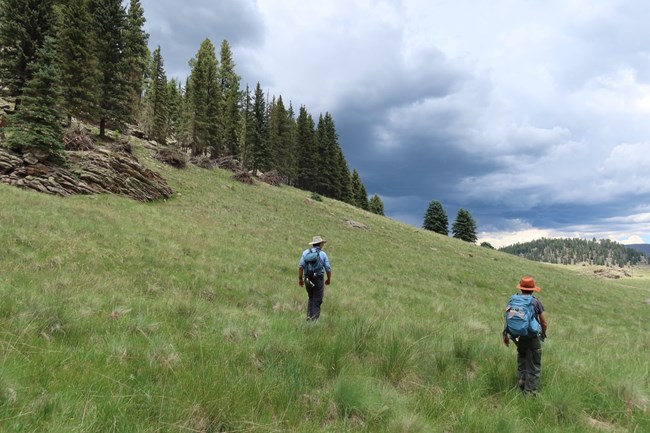Last updated: September 25, 2024
Article
Hunters & Huggers: On a Quest for Valles Caldera's Treasure Trunks

NPS/L. Ray
These are the mornings that Liz Aicher lives for. Aicher, the lead volunteer for Valles Caldera National Preserve’s “Big Tree Project,” is a self-proclaimed “hunter and hugger” who relishes in the sense of discovery with every trip into the park’s rugged backcountry. During hiking season, Aicher and fellow volunteers meet several times per month to search for Valles Caldera’s largest trees.

Photo courtesy of Liz Aicher
The bole—or trunk—is measured for circumference. At Valles Caldera National Preserve, the trees with the biggest boles are likely among the few survivors of 20th century logging and 21st century wildfires, deeming them highly valued resources for park science and research.
“The big trees that did survive contain hundreds of years’ worth of environmental history and are of great scientific and cultural significance. Finding these big trees enables the park and researchers to study Valles Caldera’s past, which enables us to manage this landscape for a sustainable future,” said Sarah Hall, botanist at Valles Caldera National Preserve.
“The Jemez Mountains host important research that uses tree ring analysis to study climate variability and fire ecology. By finding these large, old trees, volunteers give researchers potential new trees to sample and study. Their work also gives us an eyes-on-the-ground account of current forest health in areas that are not frequently visited by park biologists,” Hall added.

Photograph courtesy of Liz Aicher
“Over the years I added three more species,” said Aicher. “Overachievers are found everywhere!” she added playfully.
After a decade of trudging through the most isolated areas of the Preserve, volunteers are still hunting for four species on that original list. Aicher says that five volunteers regularly assist with the Big Tree Hunt, but she would love to recruit more.
“I like to start as soon as the snow is mostly gone in March or April, and we end the season sometime in November. We always manage to have a good time in the most wonderful collection of ecosystems here in New Mexico.”
However, Aicher claims that these outings are not always “a walk in the park.”
“We sometimes are lucky enough to be able to follow an old logging road or an elk trail, but much of the time we are hiking up and down steep slopes, through bunch grasses, climbing over deadfall and slipping on rocks. We cover anywhere from three to nine miles per outing, and we are generally out for five to seven hours,” she said.

Photo courtesy of Anita Boshier
“Valles Caldera National Preserve is relatively unique within the National Park Service in that our founding legislation mandates us to have a science program that supports ecological restoration and adaptive management," said Hall. "The Big Tree Project is a wonderful volunteer-led citizen science program that helps us fulfill that directive. Liz Aicher spends a great deal of her personal time to contribute research that helps all of us better understand the ecological history of the Preserve and supports our science-based adaptive management."
She added, “Our Big Tree volunteers are very dedicated and love the work they do. They are the Indiana Joneses of tree surveys – hiking through far-flung corners of the Preserve to make new discoveries!”
For more information or to volunteer, please visit our Volunteer webpage or contact vall_info@nps.gov.
